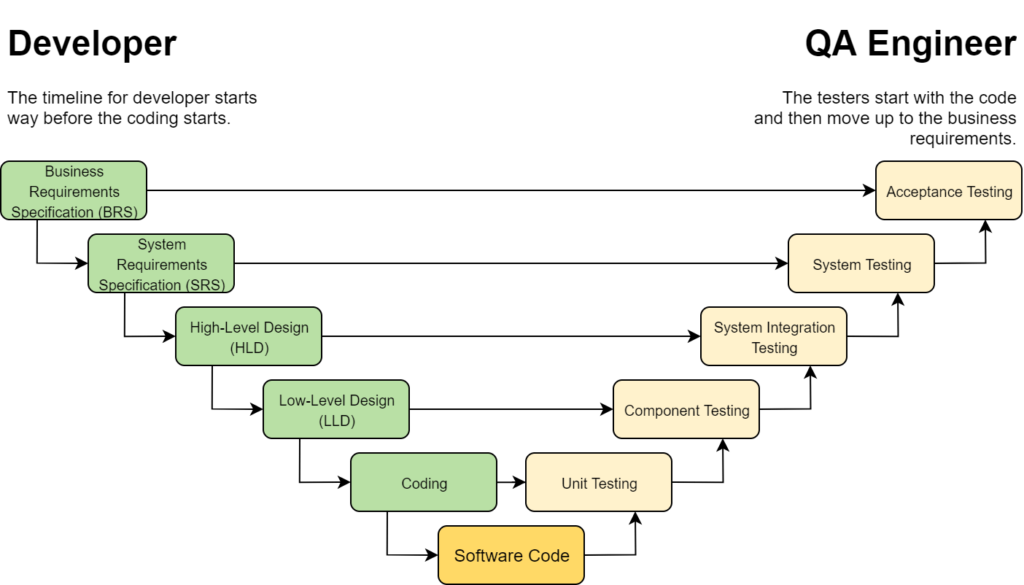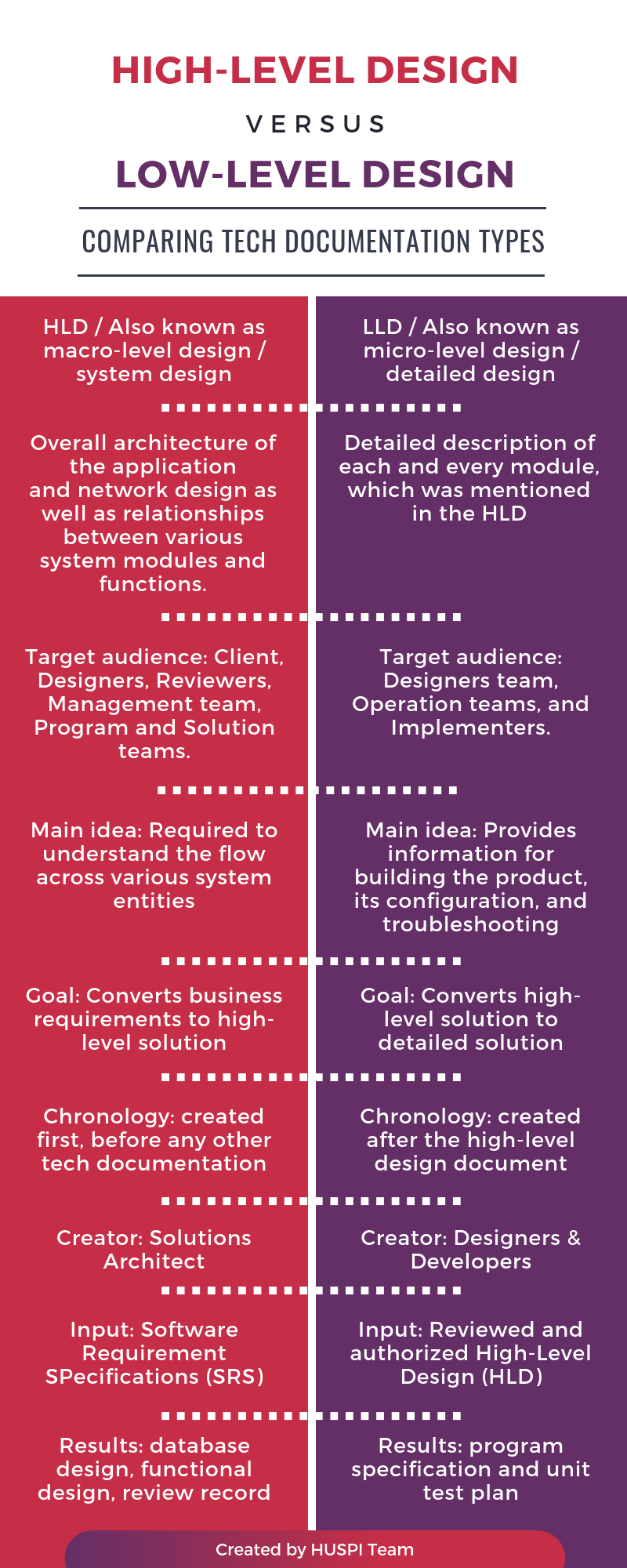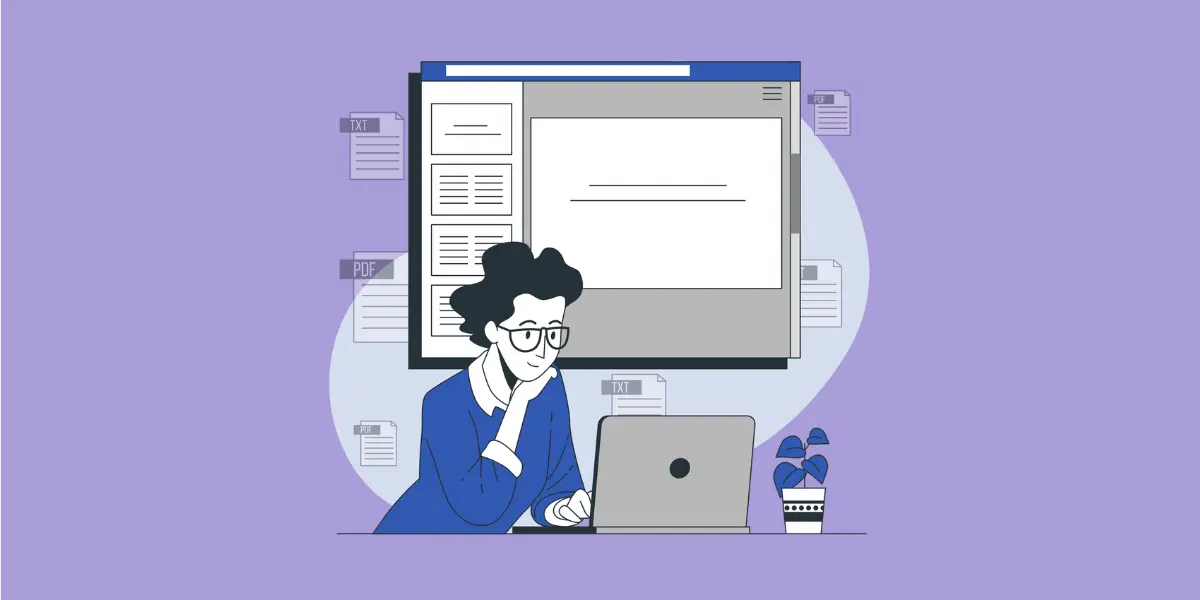Technical documentation creation is a critical step for a successful IT project, whether big or small. When you have a team working on the same product building it for someone else, communication is vital.
In the fast-paced world of healthcare software development, clear communication is paramount. Technical documentation (TD) serves as a critical bridge, ensuring everyone involved in your project is on the same page.
Here’s how robust TD benefits your healthcare project:
The project development process requires continuous communication between the team members.

There are several types of technical documentation. You need to understand the differences between high-level design (HLD), detailed design (DD), and low-level design (LLD) to be able to effectively communicate with the development team and make informed decisions about their software project. In this article, we’ll look at each one.
What should you, as a client, know about LLD, HLD, and DD? Understanding the Blueprint
As you embark on your healthtech project with HUSPI, you’ll encounter terms like LLD, HLD, and DD. These acronyms represent different levels of technical documentation, each playing a crucial role in bringing your vision to life.
HLD: High-Level Design – The Big Picture
Think of the HLD as a roadmap for your project. It provides a high-level overview of the system’s architecture, key components, and how they interact. This document focuses on functionality and user experience, outlining the major features and functionalities of your healthtech solution.
Benefits for You:
- Clear Vision: The HLD ensures you have a clear understanding of the overall system design and how it will meet your project objectives.
- Informed Decisions: Knowing the high-level architecture allows you to provide valuable feedback and participate in key decision-making processes.
LLD: Low-Level Design – Digging Deeper
The LLD dives deeper into the technical specifics, focusing on the internal workings of individual modules and functionalities. It outlines the specific algorithms, data structures, and technologies used to implement each part of the system.
Benefits for You:
- Transparency: The LLD gives you a glimpse into the technical intricacies of your project, assuring confidence that HUSPI’s development team is utilizing the most appropriate technologies.
- Quality Assurance: A well-defined LLD serves as a foundation for thorough testing, ensuring the final product performs as intended.
DD: Detailed Design – Filling in the Gaps
The DD bridges the gap between HLD and LLD. It provides detailed specifications for specific modules, functionalities, and user interfaces. Think of it as the user manual for developers, outlining the precise implementation steps and technical details.
Benefits for You:
- Clear Expectations: The DD ensures everyone involved in the development process is on the same page regarding specific functionalities and their implementation.
- Reduced Risk: A comprehensive DD minimizes the potential for misunderstandings and misinterpretations, leading to a smoother development process and reduced risk of errors.
Working with HUSPI:
At HUSPI, we take pride in clear communication throughout the project lifecycle. We actively involve you in reviewing and understanding these documents, ensuring you’re comfortable with the technical direction of your healthtech project.
Remember: These documents are not meant to overwhelm you. They serve as valuable tools for transparency, communication, and ensuring your project is built on a solid foundation. Don’t hesitate to ask questions and seek clarification whenever needed. We’re here to guide you every step of the way!
Types of Design
High-Level Design (HLD): Charting the Course for Your HealthTech Solution
High-Level Design (HLD) is a general system design. In software development, high-level design (HLD) is the process of creating an abstract representation of a software system before detailing the lower-level design. The high-level design provides a broad overview of the software architecture, including the overall structure and organization of the system, the main components and their interactions, and the main algorithms and data structures that will be used.
It includes the description of the following parts:
- System architecture
- Database design
- A brief mention of all the platforms, systems, services, and processes the product would depend on
- Brief description of relationships between the modules and system features
All the data flows, flowcharts, data structures, etc. are in these docs so that developers can understand how the system is expected to work about the features and the database design.
The goal of HLD is to provide a clear and comprehensive understanding of the system’s functionality, performance, and scalability, as well as its key constraints and trade-offs. This information is used to guide the development of the system and to ensure that it meets the requirements and satisfies the constraints of the problem domain.
Think of the HLD as the answer to these key questions:
- Overall Structure: How will the various components of your healthtech solution work together?
- Main Functions: What are the core functionalities your application will deliver?
- User Experience: How will users interact with the system to achieve their goals?
The HLD process typically involves several steps, including:
- Identifying the system’s requirements and constraints
- Identifying the key components and their interfaces
- Identifying the main algorithms and data structures
- Identifying the system’s overall structure and organization
- Identifying any external dependencies or interfaces
- Identifying any performance or scalability concerns
The output of the HLD process is typically a set of diagrams, such as block diagrams, entity-relationship diagrams, or class diagrams, that describe the system’s architecture at a high level. The HLD is usually reviewed by the stakeholders, including the customer, development team, and management, to ensure that it meets their expectations and that the proposed design is feasible and will meet the requirements.
It’s important to note that the High-Level Design is a non-technical representation of the system, it does not include low-level details like, for example, specific programming languages, libraries, or any other technical details, which will be explained in the Low-Level Design (LLD).
Your Role as a Client:
While the specifics of the HLD are crafted by HUSPI’s technical team, we believe in open communication. We’ll actively involve you in reviewing the HLD, ensuring you’re comfortable with the proposed architecture and have the opportunity to ask questions and provide feedback.
Remember: The HLD is a crucial tool for ensuring your healthtech project is built on a solid foundation. By working collaboratively, we can translate your vision into a solution that delivers impactful results in the healthcare field.
Low-Level Design (LLD): Delving Deeper into Your HealthTech Project
Low-Level Design (LLD) is a component-level design process that follows a step-by-step refinement process. It provides the details and definitions for the actual logic for every system component. It is based on HLD but digs deeper, going into the separate modules and features for every program to document their specifications. It acts as a blueprint for each component and functionality within the system.
Think of the LLD as:
- The Engineer’s Handbook: Providing in-depth details about algorithms, data structures, and specific technologies used to build each module.
- A Microscope for Functionalities: Zooming in on the internal workings of individual features, outlining their logic and implementation steps.
Are LLD and DLD the same or is there a difference?
In software development, low-level design (LLD) and detailed design (DD) refer to similar but slightly different stages in the design process.
LLD is the process of taking the high-level design (HLD) and creating a more detailed, technical representation of the system. The LLD defines the specific data structures and algorithms that will be used, as well as the interfaces between the components of the system. It also addresses issues such as error handling and recovery and defines any necessary data validation rules. The goal of LLD is to provide a clear, step-by-step plan for the implementation of the system, including detailed pseudocode or other representations of the algorithms and data structures that will be used.
Detailed Design (DD) is a phase in the software development process where the software design is transformed into a detailed design that can be used to guide the implementation of the system. DD is the next step after HLD and LLD, it could include all the elements of LLD, but with more depth and detail. It includes specific, detailed descriptions of the data structures, algorithms, interfaces, and other elements of the system, as well as pseudocode or other representations of the code that will be written. DD may also specify any specific design patterns that will be used in the implementation of the system.
The Importance of Both in HealthTech Projects
Both LLD and DD play crucial roles in ensuring the smooth development of your healthtech project:
- LLD: Guarantees efficient and reliable implementation of each module, minimizing errors and ensuring a robust technical foundation.
- DD: Promotes clear communication and reduces the risk of misunderstandings between stakeholders and developers, leading to a smoother development process.
At HUSPI:
We understand that navigating technical terminology can be challenging. We will actively explain the differences between LLD and DD and ensure you have a clear understanding of both. We’ll involve you in reviewing these documents and provide summaries and clarifications whenever needed.
In summary, Low-Level Design is the process of taking the high-level design and creating a more detailed, technical representation of the system. The Detailed Design is an extension of the Low-Level Design, which provides a very detailed design of the software system.
Your Role as a Client:
While HUSPI’s technical experts craft the LLD, we understand your interest in the project’s inner workings. We’ll provide summaries and explanations of the LLD, ensuring you’re comfortable with the technical approach and have the opportunity to ask questions for clarification.
Detailed-Level Design (DD)
Detailed Level Design (DLD) is the most detailed technical document, which describes user stories, error processing algorithms, state transitions, logical sequences, and others. DLD describes the interaction of every low-level process with each other. As we noted above, DLD is the extension of the Low-Level Design (LLD.)
The DD acts as a bridge between the high-level overview (HLD) and the detailed technical specifics of the LLD. It provides more granular details than the HLD but isn’t as specific as the LLD. Here’s what a DD typically focuses on:
- Detailed Specifications for Specific Components: This includes user interfaces, functionalities, and data models, outlining them in more detail than the HLD.
- Implementation Steps: The DD may outline the specific steps and technical requirements for implementing certain functionalities.
Think of the DD as:
- A detailed instruction manual for building each component, bridging the gap between the overall plan and the technical specifics.
- A tool for ensuring everyone involved in the development process has a clear understanding of specific functionalities and their implementation.
You might also be interested: What Code Repository to Choose for Your Project
HealthTech HLD vs LLD
| High-Level Design | Low-Level Design |
|---|---|
| HLD is a macro-level design or system design. It allows seeing the “Big Picture.” | LLD is a micro-level design or detailed design. It allows seeing the minutiae. |
| The overall architecture of the application and the network design as well as relationships between various system modules and functions. | A detailed description of each and every module that is mentioned in the high-level design (HLD.) |
| Target audience: clients, designers, reviewers, management team members, and program and solution teams. | Target audience: designer teams, operation teams, and implementers. |
| Main idea: HLD is required to understand the flow across various system entities. For example, if you have several integrated solutions, HLD describes how everything works as a single organism. | Main idea: provides information for building the product, its configuration, and troubleshooting. For example, if you have several solutions, LLD describes each one in detail, like a single organ in a body. |
| Goal: converts business goals and requirements into a high-level solution. | Goal: converts a high-level solution into a detailed solution ready for building. |
| Chronologically, HLD is created before any other technical documentation. | Chronologically, LLD is created after the high-level design document. |
| HLD Creator: Solutions Architect. | LLD Creator: Designers & Developers with PM. |
| Input Data: software requirement specifications (SRS.) | Input Data: reviewed and authorized high-level design document (HLD.) |
| Results: database design, functional design, and review record. | Results: program specification and unit test plan. |
Here is a convenient infographic that shows the difference between HLD and LLD:




